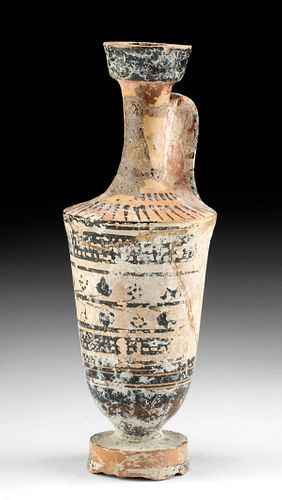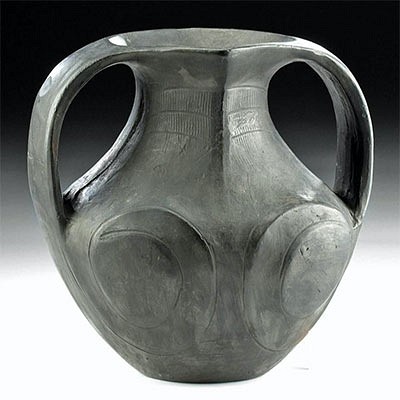Greek Attic Pottery White-Ground Lekythos
Lot 18a
About Seller
Artemis Gallery
686 S Taylor Ave, Ste 106
Louisville, CO 80027
United States
Selling antiquities, ancient and ethnographic art online since 1993, Artemis Gallery specializes in Classical Antiquities (Egyptian, Greek, Roman, Near Eastern), Asian, Pre-Columbian, African / Tribal / Oceanographic art. Our extensive inventory includes pottery, stone, metal, wood, glass and textil...Read more
Categories
Estimate:
$700 - $1,050
Absentee vs Live bid
Two ways to bid:
- Leave a max absentee bid and the platform will bid on your behalf up to your maximum bid during the live auction.
- Bid live during the auction and your bids will be submitted real-time to the auctioneer.
Bid Increments
| Price | Bid Increment |
|---|---|
| $0 | $25 |
| $300 | $50 |
| $1,000 | $100 |
| $2,000 | $250 |
| $5,000 | $500 |
| $10,000 | $1,000 |
| $20,000 | $2,500 |
| $50,000 | $5,000 |
| $100,000 | $10,000 |
| $200,000 | $20,000 |
About Auction
By Artemis Gallery
Dec 16, 2021
Set Reminder
2021-12-16 10:00:00
2021-12-16 10:00:00
America/New_York
Bidsquare
Bidsquare : VARIETY SALE | Antiquities & Ethnographic Art
https://www.bidsquare.com/auctions/artemis-gallery/variety-sale-antiquities-ethnographic-art-8026
Featuring classical antiquities, ancient and ethnographic art from cultures encompassing the globe. Egyptian, Greek, Roman, Etruscan, Near Eastern, Asian, Pre-Columbian, Native American, African / Tribal, Oceanic, Spanish Colonial, Russian, Fossils, Fine Art, more! Artemis Gallery info@artemisgallery.com
Featuring classical antiquities, ancient and ethnographic art from cultures encompassing the globe. Egyptian, Greek, Roman, Etruscan, Near Eastern, Asian, Pre-Columbian, Native American, African / Tribal, Oceanic, Spanish Colonial, Russian, Fossils, Fine Art, more! Artemis Gallery info@artemisgallery.com
- Lot Description
Ancient Greece, Athens (Attic), ca. 5th century BCE. A slender cylindrical vessel with a pronounced flat foot, a thin neck rising to a flared, flat rim, a small strap handle, and a tapered body. The body is decorated with two panels of cross-hatching, fretted lines enclosing a bifurcated section of leaves and berries. The shoulder displays a radiating register of ray band patterns, with additional black pigment adorning the foot, handle, and rim. Size: 2.375" W x 6.375" H (6 cm x 16.2 cm).
Lekythos vases were among the various offerings and monuments paying tribute to the deceased in Athenian cemeteries. Lekythos vessels traditionally held oil and were decorated in the white ground technique from the middle until the end of the fifth century BCE. The term white ground relates to the light slip coating on the body and shoulder of the vase. Upon this background, motifs were drawn in outline and then hand painted in rich colors. The vast majority of these vessels were created for burial with the dead or to be offerings presented at their graves.
Provenance: East Coast collection, New York Gallery, New York City, New York, USA, acquired before 2010
All items legal to buy/sell under U.S. Statute covering cultural patrimony Code 2600, CHAPTER 14, and are guaranteed to be as described or your money back.
A Certificate of Authenticity will accompany all winning bids.
PLEASE NOTE: Due to recent increases of shipments being seized by Australian & German customs (even for items with pre-UNESCO provenance), we will no longer ship most antiquities and ancient Chinese art to Australia & Germany. For categories of items that are acceptable to ship to Australia or Germany, please contact us directly or work with your local customs brokerage firm.
Display stands not described as included/custom in the item description are for photography purposes only and will not be included with the item upon shipping.
#135335Vessel repaired from multiple pieces with some areas of restoration and overpainting, resurfacing, small chips, and light adhesive residue along break lines. Surface wear and abrasions commensurate with age, small chips to rim, handle, shoulder, body, and foot, with fading to some pigmentation, and light roughness across most surfaces. Nice earthen deposits and encrustations throughout.Condition
- Shipping Info
-
All shipping is handled in-house for your convenience. Your invoice from Artemis Gallery will include shipping calculation instructions. If in doubt, please inquire BEFORE bidding for estimated shipping costs for individual items.
-
- Buyer's Premium



 EUR
EUR CAD
CAD AUD
AUD GBP
GBP MXN
MXN HKD
HKD CNY
CNY MYR
MYR SEK
SEK SGD
SGD CHF
CHF THB
THB














